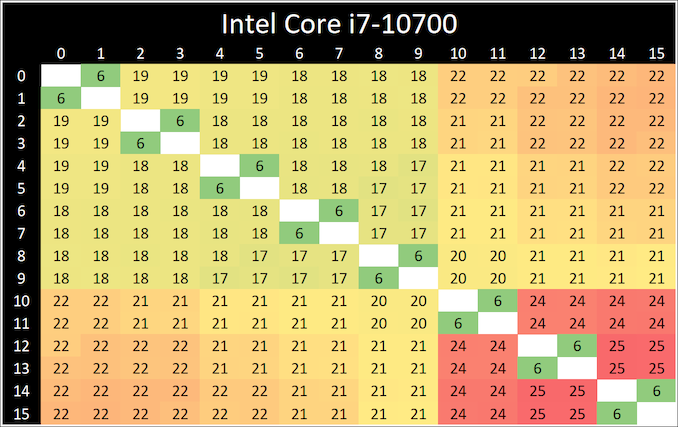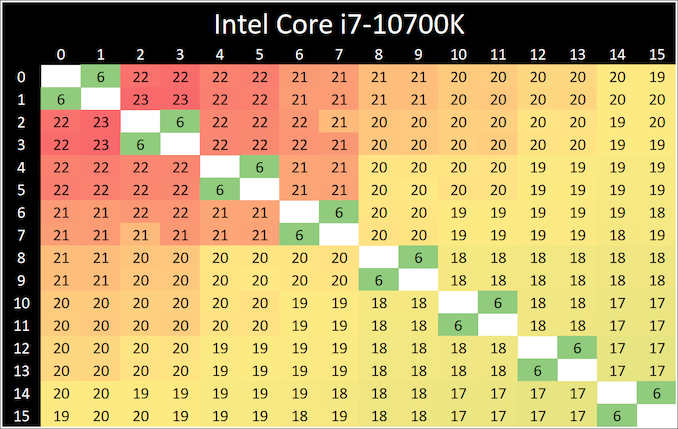Intel Core i7-10700 vs Core i7-10700K Review: Is 65W Comet Lake an Option?
by Dr. Ian Cutress on January 21, 2021 10:30 AM EST- Posted in
- CPUs
- Intel
- Core i7
- Z490
- 10th Gen Core
- Comet Lake
- i7-10700K
- i7-10700
CPU Tests: Microbenchmarks
Core-to-Core Latency
As the core count of modern CPUs is growing, we are reaching a time when the time to access each core from a different core is no longer a constant. Even before the advent of heterogeneous SoC designs, processors built on large rings or meshes can have different latencies to access the nearest core compared to the furthest core. This rings true especially in multi-socket server environments.
But modern CPUs, even desktop and consumer CPUs, can have variable access latency to get to another core. For example, in the first generation Threadripper CPUs, we had four chips on the package, each with 8 threads, and each with a different core-to-core latency depending on if it was on-die or off-die. This gets more complex with products like Lakefield, which has two different communication buses depending on which core is talking to which.
If you are a regular reader of AnandTech’s CPU reviews, you will recognize our Core-to-Core latency test. It’s a great way to show exactly how groups of cores are laid out on the silicon. This is a custom in-house test built by Andrei, and we know there are competing tests out there, but we feel ours is the most accurate to how quick an access between two cores can happen.
When we first reviewed the 10-core Comet Lake processors, we noticed that a core (or two) seemed to take slightly longer to ping/pong than the others. These two parts are both derived from the 10-core silicon but with two cores disabled, and we still see a pattern of some cores having additional latency. The ring on the 8-core parts still acts like a 10-core ring, but it all depends on which cores were disabled.
Frequency Ramping
Both AMD and Intel over the past few years have introduced features to their processors that speed up the time from when a CPU moves from idle into a high powered state. The effect of this means that users can get peak performance quicker, but the biggest knock-on effect for this is with battery life in mobile devices, especially if a system can turbo up quick and turbo down quick, ensuring that it stays in the lowest and most efficient power state for as long as possible.
Intel’s technology is called SpeedShift, although SpeedShift was not enabled until Skylake.
One of the issues though with this technology is that sometimes the adjustments in frequency can be so fast, software cannot detect them. If the frequency is changing on the order of microseconds, but your software is only probing frequency in milliseconds (or seconds), then quick changes will be missed. Not only that, as an observer probing the frequency, you could be affecting the actual turbo performance. When the CPU is changing frequency, it essentially has to pause all compute while it aligns the frequency rate of the whole core.
We wrote an extensive review analysis piece on this, called ‘Reaching for Turbo: Aligning Perception with AMD’s Frequency Metrics’, due to an issue where users were not observing the peak turbo speeds for AMD’s processors.
We got around the issue by making the frequency probing the workload causing the turbo. The software is able to detect frequency adjustments on a microsecond scale, so we can see how well a system can get to those boost frequencies. Our Frequency Ramp tool has already been in use in a number of reviews.
Both processors ramp from idle to full turbo in about six milliseconds, well within a single frame of standard gaming.













210 Comments
View All Comments
Spunjji - Monday, January 25, 2021 - link
Assuming makes an ass out of, well, just you in this case.You replied to - and agreed with - a comment from someone who clearly didn't properly read the article, because their complaints were addressed within the article.
I can't "refute" your personal opinions because they were just that; opinions. I can - and did - freely imply that I think they're bad opinions and are based around motivated reasoning. If you think that backs you up, you're even less logical than this "debate me" shtick implies.
Spunjji - Friday, January 22, 2021 - link
That is, in fact, mentioned in the article. If only people would read before commenting.hansip87 - Thursday, January 21, 2021 - link
One of the things i wonder is, with Asrock Turbo Unlock only allows 125W max (z490m itx ac), will it be worth the money to purchase the K version just so we can tinker with the PL1&2 value? I mean, compared to 6core which can make do with 125watt, 8 core should go around 160w. The motherboard used here might allow TDP bigger than 125w load but what happened with boards that do limit them only with 125watt?Endymio - Thursday, January 21, 2021 - link
-> "Also when it comes to benchmarking, because if we were to take an extreme view of everything, then benchmarking is pointless and I'm out of a job."A very good article, but the above sentence is syntactic gibberish. There are several other grammatical errors/typos that an editor -- or even good editing software -- should have caught.
MDD1963 - Thursday, January 21, 2021 - link
At any point, did anyone perhaps run HWmonitor to see what clock speeds were being achieved on the 10700? If only 100 MHz less than the 10700K, clearly we are NOT running in a true 65W TDP envelope...MDD1963 - Thursday, January 21, 2021 - link
Many folks still referred to the R7-1700X as a 65 watt CPU when running it at 3.9 GHz in it clearly drawing 140-165W from the wall at load...same as the 1800X. (I'm sure criticisms flew equally Team Red back then, right?) :)zeealpal - Thursday, January 21, 2021 - link
Everywhere I look references the R7-1700X TDP as 95W not 65W? With ~108W full package power draw at load https://www.anandtech.com/bench/product/2281shabby - Thursday, January 21, 2021 - link
Fake news...Spunjji - Friday, January 22, 2021 - link
Nice FUD / JAQing off combo you're doing, there! 😑The 1700 had a 65W TDP, and it drew ~45W in games and ~82W running Prime 95.
The 1700X and 1800X had a 95W TDP and drew ~105W and ~113W in Prime 95, respectively
Those chips were pretty roundly criticised for their low power efficiency vs. Intel in lightly threaded workloads at the time. 👍
eastcoast_pete - Thursday, January 21, 2021 - link
This might be a too simple-minded approach, but even the most overdone power regulation will run into the declared thermal limit if the heatsink that is used is speced according to the declared "TdP". So, if you'd give a "65Wh CPU" a heatsink that can only dissipate 65 Wh sustained, the CPU would run into it's thermal shutdown temperature. That would unmask mislabeled CPUs quickly. Just a suggestion.